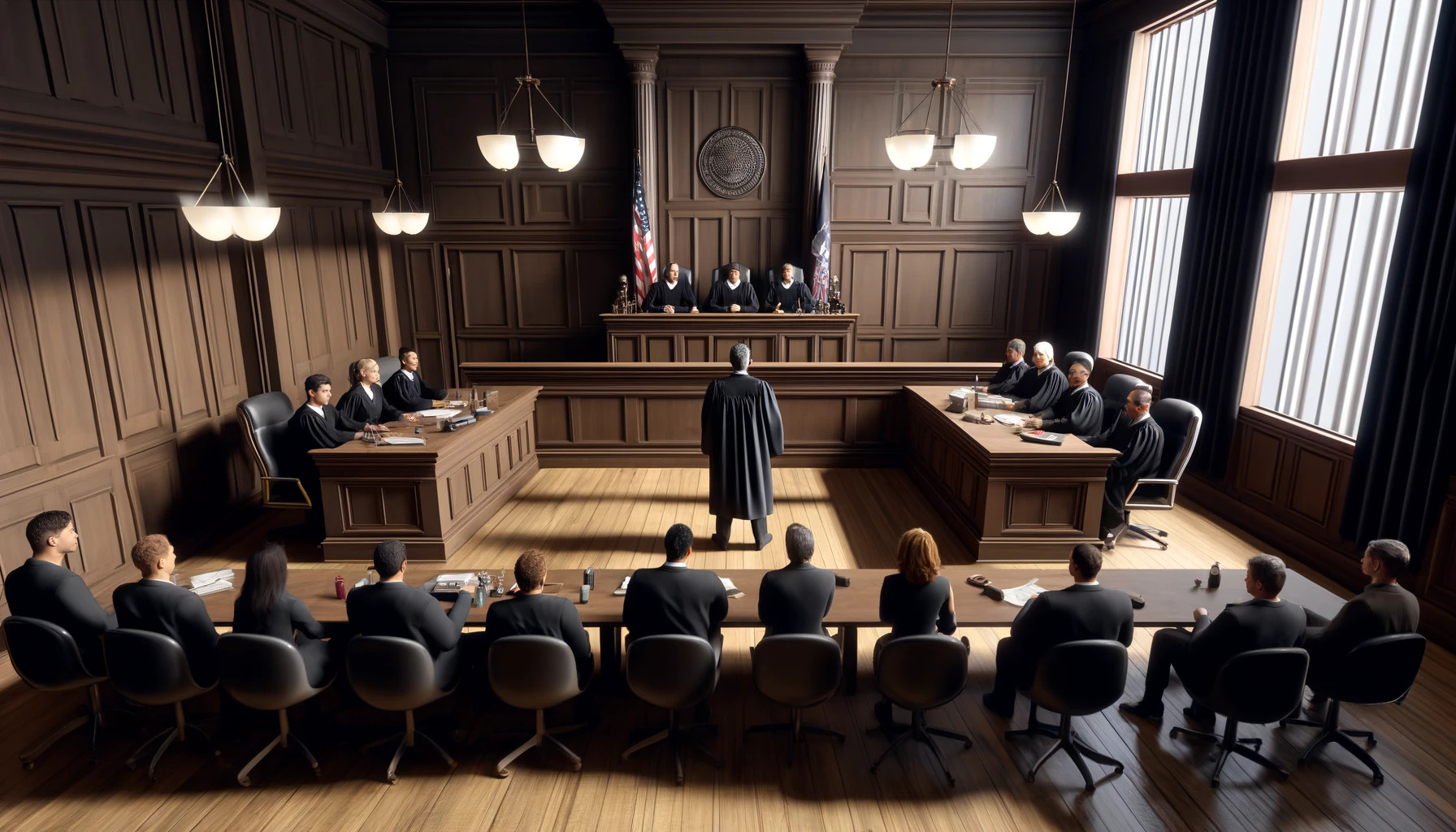Initial Case Assessment
When we first take on a personal injury case, the initial assessment is crucial. This stage sets the tone for the attorney-client relationship, establishes the factual basis for identifying the at-fault party, and necessitates a thorough understanding of the relevant laws that will govern the case.
Client-Attorney Relationship
During the initial consultation, we prioritize establishing a strong attorney-client relationship. Personal injury cases hinge on this bond, as it enables open communication and trust. An experienced personal injury lawyer will explain the client’s rights, the legal process, and what can be expected as the case progresses. This relationship must be formalized through an agreement that outlines our duties and the client’s responsibilities during the lawsuit.
- Key Components:
- Open and clear communication
- Explanation of client’s rights
- Outline of legal process
Identification of the At-Fault Party
Identifying the party responsible for the injury is a critical step in the initial case assessment. We gather facts and evidence to determine who is liable and assess the extent of the client’s injuries. This process often involves reviewing accident reports, speaking with witnesses, and analyzing medical records. Establishing fault is essential not only for case strategy but also for ensuring that the statute of limitations is appropriately considered to avoid jeopardizing the case.
- Evidence Collection:
- Accident reports
- Witness statements
- Medical records
Understanding of Applicable Laws
As we delve into the personal injury case, we ensure a comprehensive review of the laws that pertain to the case. These include the statute of limitations, which varies by jurisdiction, and dictates the timeframe within which a lawsuit must be filed. Understanding and applying these laws correctly is integral to the success of the case. We also review specific legal precedents and standards of negligence that apply to the circumstances of the incident.
- Legal Aspects to Consider:
- Statute of limitations
- Jurisdiction-specific laws
- Standards of negligence
Evidence Collection and Analysis
In a personal injury lawsuit, the strength of the case often hinges on our ability to meticulously gather and scrutinize the evidence. This involves a systematic approach to collecting documentation, conducting interviews, and assessing medical records.
Gathering Relevant Documentation
We begin by collecting all pertinent evidence to support the case, which includes but is not limited to police reports, photographs of the scene, and eyewitness statements. Documentation acts as the backbone of the legal argument. We organize this evidence in a coherent manner to present a compelling narrative for our client.
- Police Reports: We procure official reports that contain crucial details about the incident.
- Evidence at the Scene: We gather photographs and any physical evidence from the accident site.
- Witness Statements: We obtain written or recorded accounts from all available witnesses.
Interviews and Depositions
Interviews and depositions play a critical role in the discovery process. We meticulously prepare and conduct interviews with all involved parties, including witnesses and experts.
- Preparation: We draft a comprehensive list of interrogatories tailored to extract detailed information.
- Execution: We conduct depositions under oath to secure admissible testimony for the trial.
Medical Records Assessment
The assessment of medical records is a pivotal component of personal injury claims. We thoroughly analyze these documents to ascertain the extent and impact of the injuries sustained.
- Initial Medical Treatment: We review records of immediate medical treatment to establish the injury’s severity.
- Ongoing Medical Examination: We continuously evaluate medical records to monitor the progression of the client’s condition.
- Medical Expert Consultation: We collaborate with medical professionals to interpret the implications of the medical findings.
Through each stage of evidence collection and analysis, we ensure that every piece of information undergoes meticulous examination to build a robust case for our client. The evidence we compile serves as a critical foundation upon which the entire case is constructed and argued in court.
Legal Proceedings and Pre-Trial Activities
In personal injury lawsuits, meticulous attention to the legal framework and strategic pre-trial actions are vital for case progression. We navigate through the initial filing, the extensive discovery process, and the critical motions that set the stage for potential trial proceedings.
Filing of Lawsuit
Once we decide to proceed with a personal injury lawsuit, the initial step is drafting and filing a complaint. This document lays out the plaintiff’s allegations and the legal basis for the claim. Simultaneously, we facilitate the issuance of a summons to notify the defendant of the lawsuit. This phase is the cornerstone of legal action, formally activating the litigation process.
Discovery Phase Execution
The discovery phase is our opportunity to gather pertinent evidence. We meticulously engage in:
- Interrogatories: Written questions required to be answered under oath.
- Depositions: Oral testimonies recorded for later use in court.
- Request for Documents: Formal solicitation of relevant documents from the other party.
- Admissions of Fact: Requests for the other party to confirm or deny certain aspects of the case.
Our adherence to the strategic exchange of information uncovers critical facts and aids in establishing the duty of care and any breach thereof.
Motions and Court Appearances
Before trial, we may file pre-trial motions—requests made to the judge seeking particular rulings on legal issues. These motions can include requests to dismiss parts of the case, compel discovery, or even determine certain facts as undisputed. Court appearances for these motions require precise preparation as they can significantly influence the trajectory of the lawsuit. Our active participation during this pre-trial process ensures that our case advances in a legally sound and efficient manner.
Negotiation and Alternative Dispute Resolution
Before we engage in a court trial, it’s crucial to explore avenues like negotiation and alternative dispute resolution. These strategies can often lead to a more expedient and less costly conclusion to a personal injury lawsuit.
Settlement Negotiation Tactics
In settlement negotiations, attorneys from both sides play pivotal roles. An insurance company usually represents the defendant if liability insurance is involved. To commence a negotiation, the injured party’s lawyer will issue a demand letter outlining the damages sought. Negotiation is a strategic process:
- Initial Offer: Our opening demand sets the scene for negotiation, often above what is realistically expected to be awarded.
- Counteroffer: In response, the defense attorney typically presents a counteroffer, which is lower than the demand.
- Bargaining: Negotiations may involve multiple rounds of counteroffers, with each side adjusting their demands in light of evidence and liability.
Strategically, we might emphasize points such as negligence or the defense’s potential weak points to strengthen our position.
Mediation
Mediation is a type of facilitated negotiation. Here, a neutral third party—the mediator—assists both sides. The mediator does not decide the case but helps facilitate discussion and, hopefully, resolution.
- Confidentiality: Mediation sessions are confidential, encouraging open dialogue.
- Non-Binding: While mediators offer guidance, their suggestions do not bind either party.
Due to its collaborative nature, mediation can lead to mutually acceptable settlements without the adversarial tone of a courtroom battle.
Arbitration
Arbitration resembles a trial but is less formal and often quicker. During arbitration:
- Both parties present evidence and arguments.
- An arbitrator acts like a judge, with the power to make a legally binding decision.
- Binding or Non-Binding: Arbitration can be either binding or non-binding. In binding arbitration, parties must accept the arbitrator’s decision as final.
- Selection of Arbitrator: Selection of a knowledgeable arbitrator is a tactical decision and is often a subject of negotiation in itself.
Arbitration is typically opted for because it is private, less formal, and can be faster than traditional court proceedings.
Trial and Verdict
When a personal injury lawsuit proceeds to court, the focus shifts to the trial’s components: court proceedings, jury decision-making, and the potential for post-trial appeals.
Court Trial Proceedings
In a civil court, the trial is a critical phase where the defense team and the plaintiff’s representation present their cases before a judge and jury. The process commences with jury selection, an intricate procedure ensuring an impartial panel. Once the jury is sworn in, both sides deliver opening statements, followed by the presentation of evidence through witness testimony and documentation.
- Opening Statements: The plaintiff and defense lay out their case narratives.
- Witness Testimony and Cross-Examination: Fact and expert witnesses provide testimony, subjected to cross-examination by the opposition.
During this stage, our legal team ensures that we clearly convey the specifics of the incident, emphasizing evidence that supports our client’s claim.
Jury Deliberation and Verdict
After hearing all the evidence, the jury retreats to deliberate on the case. Here, they review facts and apply the law, as instructed by the judge, to reach a verdict.
- Deliberation Process: This is an opportunity for jurors to discuss the evidence and come to a consensus.
- Verdict Announcement: The decision, unanimous or majority based, is reported back in the courtroom.
If the jury finds in favor of our client, they may also determine the amount of compensation.
Post-Trial Appeals
The conclusion of a trial does not necessarily mean the end of the case. The losing party has the right to file an appeal, challenging the verdict or aspects of the trial they believe were legally incorrect.
- Filing an Appeal: A formal request asking a higher court for review.
- Legal Grounds for Appeal: Claims of legal errors that might have affected the jury’s decision or the verdict’s fairness.
Our role is to advocate for our client’s legal rights through every step, ensuring that any appeal is addressed with the same rigor and attention as the initial trial.
Frequently Asked Questions
When considering a personal injury lawsuit, understanding the evaluation process is crucial. We’ll address some of the common inquiries to demystify what factors affect a claim, typical lawsuit steps, timeframe, case evaluations, settlement calculations, and the conclusion of a claim.
What factors are considered in evaluating a personal injury claim?
In assessing a personal injury claim, we review the extent of injuries, impact on quality of life, lost wages, medical expenses, liability, and evidence provided. Each factor plays a pivotal role in building a strong case.
What are the typical steps involved in a personal injury lawsuit?
A typical personal injury lawsuit begins with a consultation and case evaluation, followed by filing a complaint, discovery, negotiation, and, if necessary, a trial. These steps can evolve as the case progresses, aiming to reach a suitable resolution.
How long does it typically take to settle a personal injury case?
The duration to settle a personal injury case varies, ranging from a few months to several years. Complexity, cooperation of the parties involved, and court schedules influence the timeline significantly.
What can I expect during a free case evaluation for a personal injury lawsuit?
During a free case evaluation, expect to provide details about the incident, related injuries, and any evidence you have. We use this time to assess the merits of your case and to discuss possible legal strategies.
How are personal injury settlement amounts typically calculated?
Personal injury settlements are calculated taking into account medical costs, pain and suffering, lost income, and future financial needs related to the injury. Using legal and financial expertise, we strive to estimate a fair amount.
What constitutes the final stage in resolving a personal injury claim?
The final stage in resolving a personal injury claim typically involves reaching a settlement agreement or receiving a court verdict. Successful resolution is marked by the compensation for damages received by the plaintiff, concluding the legal process.




